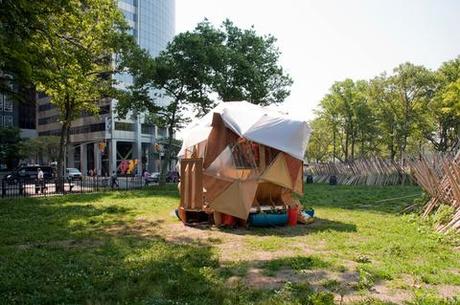
Last summer, four small huts colonized New York City. Rather than ramshackle shanties, however, each one was a model of self-sufficiency. Meet the Flock Houses, brainchildren of artist and activist Mary Mattingly.
As home foreclosures and job losses send people roaming the country, New York–based artist Mary Mattingly sees an impending reality in which migratory living becomes the solution to financial, political, and environmental decay.
Last summer Mattingly and her team of collaborators created the Flock House Project, a four-month experiment in sustainable urban nomadism. From June through September, four single-occupancy microspheres circulated throughout New York City's five boroughs, inhabited by people willing to stress-test the designs.
Each modular structure was fabricated using an array of materials like reclaimed wood and Plexiglas, spliced metal ladders, reused fabrics, and even plastic zip ties. Solar panels and a bike-powered generator provide electricity for each unit, while pot-to-pot refrigeration cools vegetables. A dry compost toilet hides in the corner; a removable hammock bed frees up floor space. Filtered rainwater sources the sink and shower, both of which supply graywater to subirrigation planters fashioned from 55-gallon drums. "The project," says Mattingly, "is an experiment and experience. Ideally, the people who encounter it are able to imagine this future and then create new stories from this one."
Living in Battery Park between the community urban garden and the Starbucks on State Street, I was the first temporary resident in the finished Flock Houses installed during the summer of 2012. Floor space was limited due to a large battery box–turned–seat and shower basin—also used to filter water for irrigation—so I stretched a hammock wall to wall for my bed. Though a few scorching days without rain meant I couldn’t test the full water cycle, I was impressed by the elongated flexible solar panel wrapping across the back and side. It was mighty enough to power a laptop—and wi-fi was already a park service freebie.
